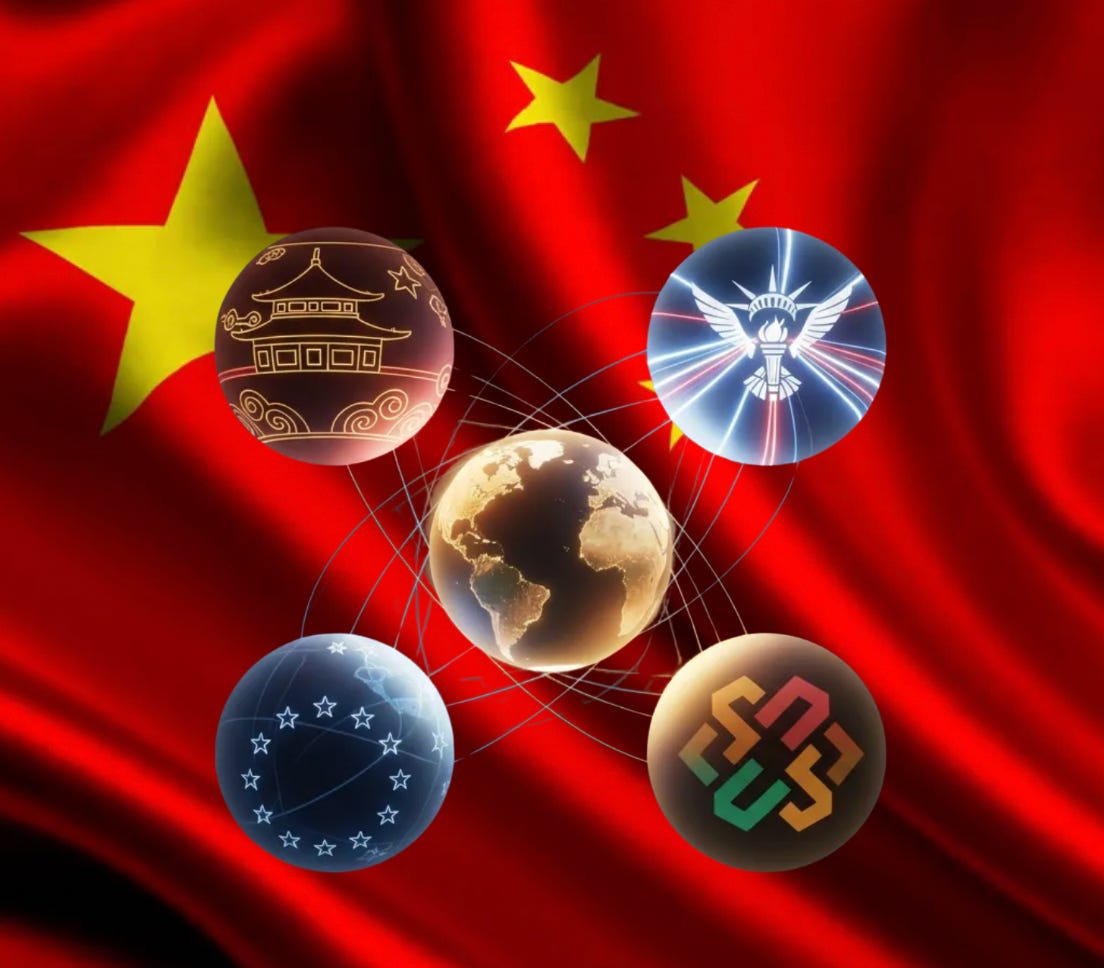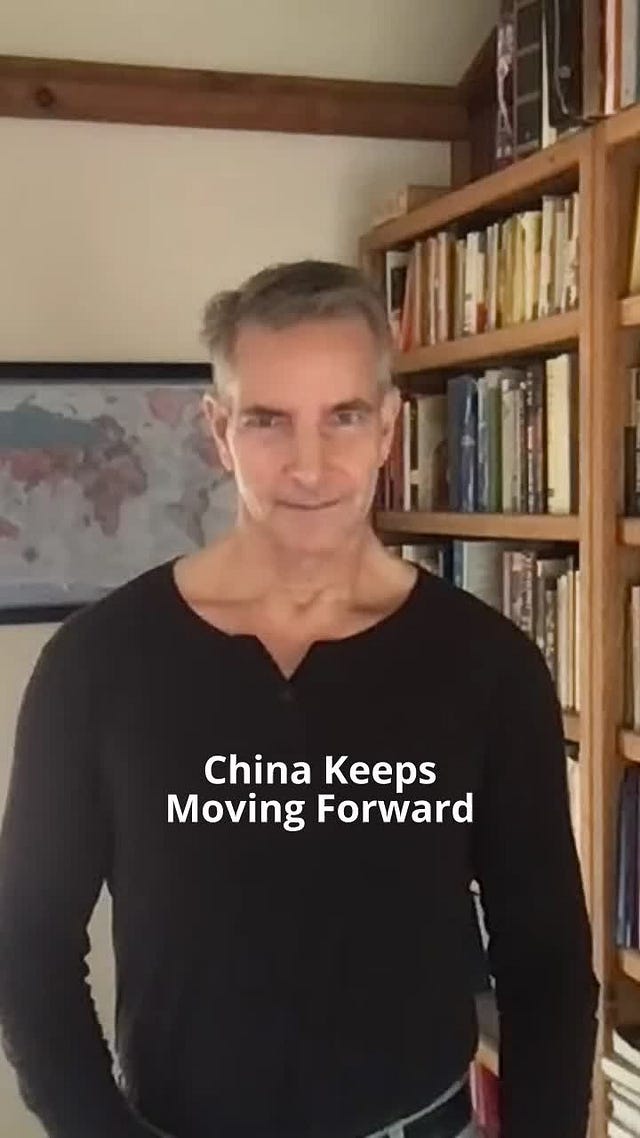Tuesday Edition — China: The Long Game
Four powers, four choices, one world
What will China’s role in a multipolar world look like? It’s already showing us. China’s path to power isn’t through conquest or ideology but through connection, trade, infrastructure, and participation in the global system built by the West.
From Isolation to Integration
China is a world power today and may well be the leading world power in the next decade because it integrated with the Western economy and global institutions. When it joined the World Trade Organization in 2001, it entered a global system built on open markets, cooperation, and predictable rules.. From there, China became an active participant in the World Health Organization, the Paris Climate Accord, and dozens of international institutions designed to keep nations peaceful and prosperous. By working within these systems, China transformed itself from a developing economy into the world’s second largest, lifting more than 800 million people out of poverty in the process and building the world’s largest middle class.
Governance by Merit
For the past four decades, China’s government has operated as a meritocracy, promoting competence over politics. Leaders are evaluated on performance, how well they improve education, infrastructure, and living standards. That system has produced a generation of experienced administrators who think in decades, not election cycles. The results are visible: modern cities, high-speed rail, and broad access to healthcare and education.
The Middle Kingdom’s Modern Role
China’s goals today remain consistent with its history. For more than 4,000 years, it has viewed itself as the Middle Kingdom, the cultural and economic center of the world, but not its conqueror. Its focus has been inward, maintaining order and stability within its borders. Global influence comes through trade and connectivity, not military expansion or regime change. Nations that wish to engage are welcomed through commerce and diplomacy; those that do not want to engage are simply left alone.
The Belt and Road Initiative is the clearest example. In Pakistan, it built the Gwadar Port, giving the region new access to global shipping routes. In Kenya, the Mombasa–Nairobi Railway cut travel time between the coast and capital from twelve hours to four. In Greece, China’s investment in the Port of Piraeus turned a failing harbor into one of Europe’s busiest. These are three examples of the thousands of projects China has already built, with thousands more planned.
Through these projects, China has linked over 150 countries into a network of ports, railways, pipelines, and fiber-optic cables. These are not colonial outposts; they are trade corridors designed to move goods, energy, and data that genuinely benefit all involved. For China, the return is both economic and strategic. It gains stable access to resources, oil from the Middle East, copper from Africa, lithium from South America, and new markets for its products and technologies. Chinese firms win construction contracts, telecommunications deals, and renewable energy projects that sustain domestic growth and employment. The infrastructure also creates reliable transport routes that shorten supply chains and reduce dependence on sea lanes controlled by other powers.
In the new multipolar world, China’s goal is to be the indispensable partner, one every nation must engage with, even if they do not share its politics.
The Cultural Perspective Behind China’s Strategy
China’s actions abroad come from the same principles that guide it at home: stability, patience, and structure. It avoids sudden change and prefers steady progress.
China is collectivist (Hofstede). The group comes first. At home, that means citizens are expected to work together toward national goals. In foreign policy, it means decisions are made through dialogue and coordination rather than confrontation.
It is also long-term oriented (Hofstede). The government plans far into the future. China’s Five-Year Plans, now in their fifteenth cycle, guide national priorities in education, industry, and technology. The Belt and Road Initiative follows the same logic. Each port or railway built abroad serves long-term trade and energy goals that secure China’s economy for decades.
Culturally, China is particularist (Trompenaars). Relationships come before rules. Trade and diplomacy depend on trust and continuity. A partner’s reliability matters more than its system of government. Nations that maintain stable, respectful ties with China, such as Pakistan, Kenya, and Greece, see ongoing investment.
In Hornby’s framework, China fits the Blue Guardian archetype. The Guardian values discipline, order, and duty. Leaders are expected to preserve stability and follow established systems. Power is not about personal ambition but about maintaining the structure that keeps society functioning.
China’s approach as a global power reflects this mindset. It builds networks instead of alliances, invests instead of invades, and relies on consistency instead of confrontation. Its power grows from reliability and cooperation, not ideology.
Why It Matters
China’s rise changes how global power works. It shows that influence can be gained through trade, infrastructure, and stability rather than military force. Nations no longer have to choose between dependence on the West or isolation from it.
China’s model appeals to many developing countries because it delivers results: ports, railways, power grids, and jobs. It does not demand political alignment or impose its ideology. For governments that want growth without outside interference, China offers a clear path.
This approach also challenges Western assumptions. It questions the idea that democracy and free markets are the only road to prosperity. China’s success shows that long-term planning, meritocratic governance, and collective stability can produce national strength, prosperity for the people, and peaceful relationships with other nations.
In the new multipolar world, this model will shape how countries trade, cooperate, and compete. China’s influence is built, not forced, and that makes it one of the most enduring forms of power in the modern era.
China’s story sets the stage for what comes next: how the European Union uses cooperation and law, rather than power, to shape the world around it.
Join us for more cultural perspective on TikTok and YouTube





